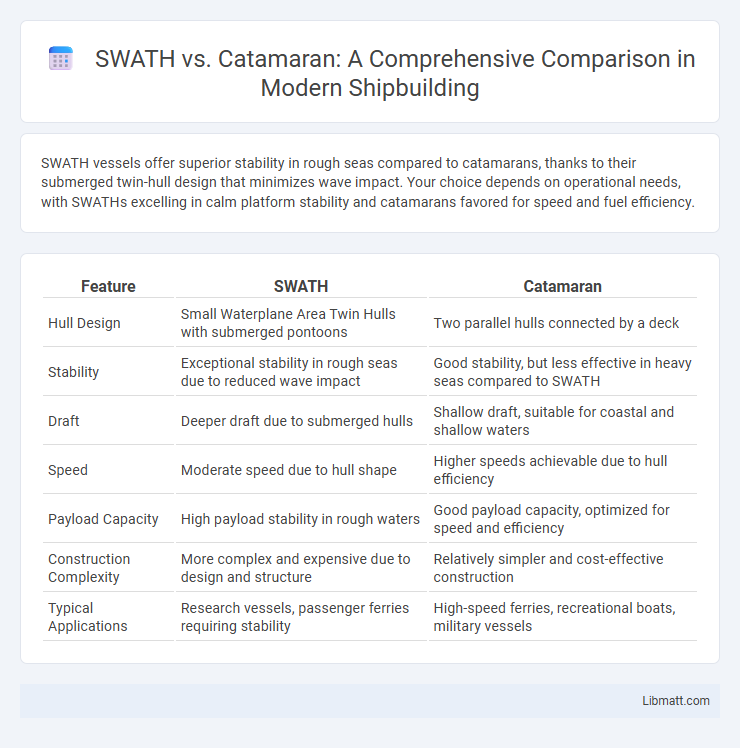SWATH vessels offer superior stability in rough seas compared to catamarans, thanks to their submerged twin-hull design that minimizes wave impact. Your choice depends on operational needs, with SWATHs excelling in calm platform stability and catamarans favored for speed and fuel efficiency.
Table of Comparison
| Feature | SWATH | Catamaran |
|---|---|---|
| Hull Design | Small Waterplane Area Twin Hulls with submerged pontoons | Two parallel hulls connected by a deck |
| Stability | Exceptional stability in rough seas due to reduced wave impact | Good stability, but less effective in heavy seas compared to SWATH |
| Draft | Deeper draft due to submerged hulls | Shallow draft, suitable for coastal and shallow waters |
| Speed | Moderate speed due to hull shape | Higher speeds achievable due to hull efficiency |
| Payload Capacity | High payload stability in rough waters | Good payload capacity, optimized for speed and efficiency |
| Construction Complexity | More complex and expensive due to design and structure | Relatively simpler and cost-effective construction |
| Typical Applications | Research vessels, passenger ferries requiring stability | High-speed ferries, recreational boats, military vessels |
Introduction to SWATH and Catamaran Vessels
SWATH (Small Waterplane Area Twin Hull) vessels feature submerged twin hulls connected by slender struts, minimizing wave resistance and providing exceptional stability in rough seas. Catamarans consist of two parallel hulls connected by a deck structure, offering a wide beam for increased stability and spaciousness, often used for high-speed ferry services. Both designs reduce drag and improve fuel efficiency compared to traditional monohull vessels, with SWATH excelling in smooth ride quality and catamarans in speed and payload capacity.
Core Design Principles: SWATH vs Catamaran
SWATH (Small Waterplane Area Twin Hull) vessels feature submerged twin hulls connected to the superstructure by slender struts, minimizing waterplane area to reduce wave-induced motion and enhance stability in rough seas. Catamarans utilize two parallel hulls with larger waterplane areas, providing high initial stability and speed but are more affected by wave action compared to SWATH designs. The core design principle of SWATH emphasizes minimizing wave interaction for comfort and stability, while catamarans prioritize efficiency and speed with a wider beam and shallower draft.
Stability Comparison: Seakeeping and Motion
SWATH vessels provide superior stability and seakeeping performance compared to catamarans due to their submerged twin hull design, which minimizes wave-induced motions and reduces pitch and roll. Catamarans offer good stability in calm waters but are more susceptible to motion disturbances in rough seas because of their wide, above-water hull configuration. Your choice depends on operational conditions, with SWATH favored for missions demanding minimal motion, such as research or passenger comfort in rough waters.
Speed and Fuel Efficiency Considerations
SWATH vessels offer superior stability in rough seas, allowing them to maintain consistent speeds with less fuel consumption during choppy conditions compared to catamarans. Catamarans generally achieve higher top speeds due to their lighter weight and slender hulls but may experience increased drag and fuel use in turbulent waters. Fuel efficiency for SWATH designs excels in operational environments requiring steady performance, whereas catamarans are optimized for speed over shorter distances in calmer seas.
Structural Strength and Durability
SWATH vessels feature deep, narrow hulls connected to a broad platform, providing exceptional structural strength and resistance to rough sea conditions. Catamarans, with their twin hull design, offer good stability and durability but may be more susceptible to hull stress in heavy waves due to shallower draft. The SWATH's submerged hulls minimize wave impact, enhancing longevity and structural integrity compared to traditional catamarans.
Cargo and Passenger Capacity Differences
SWATH vessels feature a unique twin-hull design that offers enhanced stability but generally have lower cargo and passenger capacities compared to catamarans, which maximize deck space and volume due to their wider beam. Catamarans can efficiently handle larger loads and accommodate more passengers, making them ideal for ferry services and cargo transport in calm to moderate sea conditions. Your choice between the two should consider the desired balance between capacity and operational environment, as SWATH vessels excel in rough waters while catamarans prioritize capacity and speed.
Operational Costs and Maintenance
SWATH vessels typically incur higher operational costs due to their complex hull design, which demands specialized maintenance and repair techniques. Catamarans benefit from simpler twin-hull construction, resulting in lower routine maintenance expenses and more readily available spare parts. You should consider your budget and long-term maintenance capabilities when choosing between these two vessel types.
Applications: Commercial, Military, and Recreational Use
SWATH vessels excel in military and commercial applications due to their superior stability in rough seas, making them ideal for surveillance, research, and offshore transport. Catamarans are favored in recreational and passenger transport for their speed and spaciousness, providing enhanced comfort and efficiency on calm waters. Your choice depends on whether mission-critical stability or passenger comfort and speed is the priority.
Environmental Impact and Sustainability
SWATH vessels generate less wave resistance and lower wake, reducing shoreline erosion and protecting marine habitats compared to traditional catamarans. Their submerged hull design improves fuel efficiency, cutting greenhouse gas emissions and promoting sustainable maritime operations. Choosing a SWATH vessel can enhance your environmental stewardship by minimizing ecological disturbances during transport.
Choosing the Right Vessel: Key Factors to Consider
When choosing between a SWATH and a catamaran, key factors include stability, draft, and operational environment. SWATH vessels offer superior stability in rough seas due to their submerged hull design, making them ideal for scientific research or passenger comfort on choppy waters. Your choice should reflect mission requirements, with catamarans favored for shallow drafts, higher speeds, and efficient fuel consumption in calmer coastal or inland waters.
SWATH vs catamaran Infographic

 libmatt.com
libmatt.com